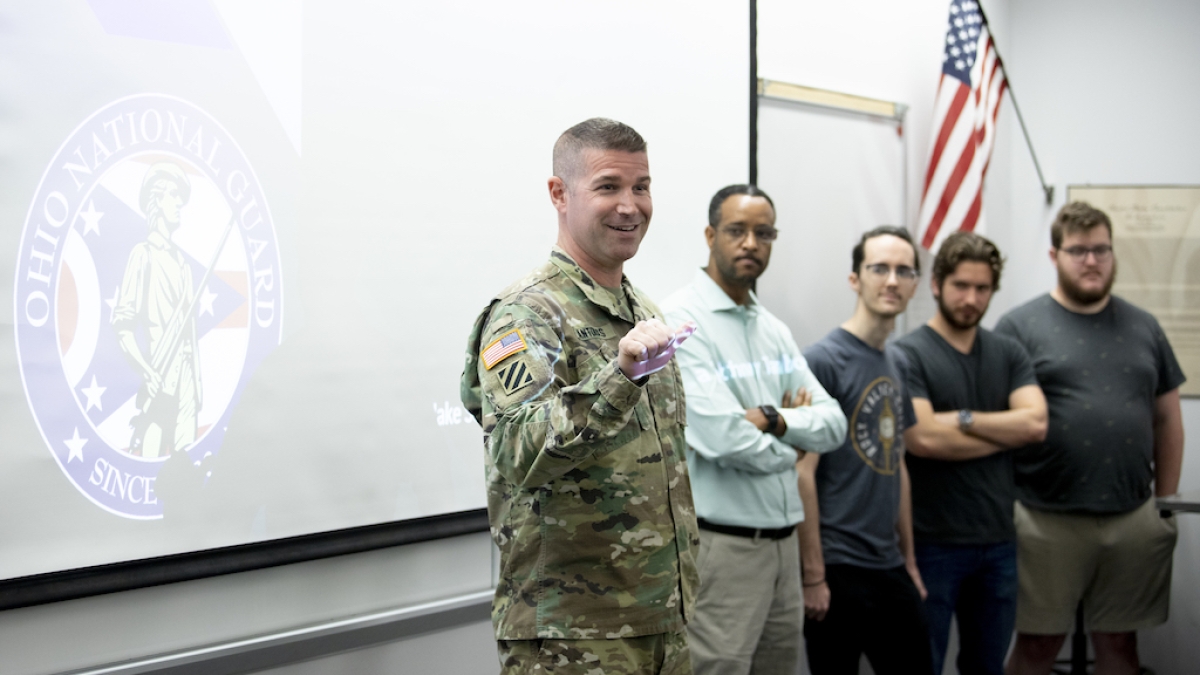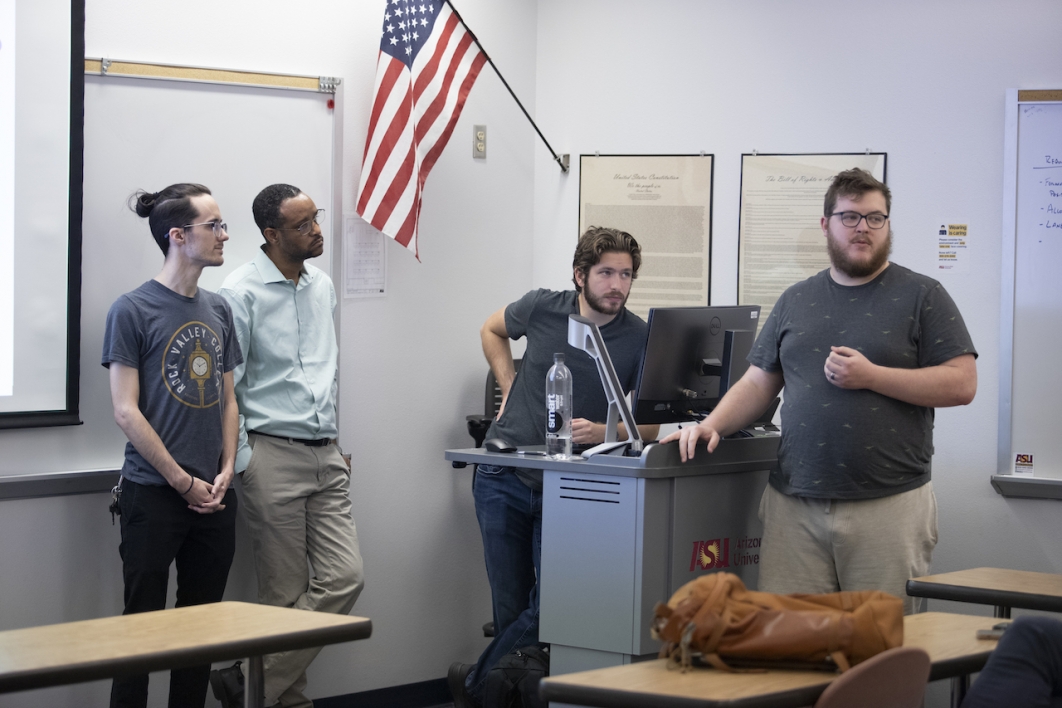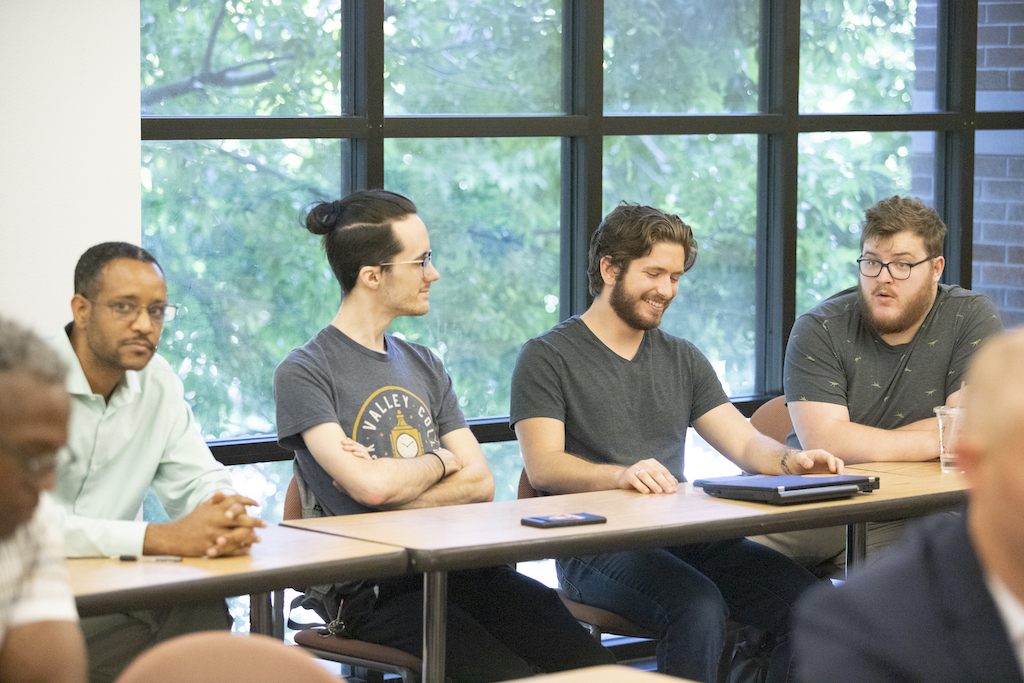ASU students solve real-world problems for Department of Defense

Maj. Mike Antonas (far left), with the Army National Guard in Ohio, flew out to ASU on Tuesday to honor a team of students in ASU's Hacking for Defense class. The course is offered by the New College of Interdisciplinary Arts and Sciences. The team successfully solved a problem for the U.S. Department of Defense. The student team (from left) included Getachew Yirga, Jacob Selover, Johnny Tamborrino and Alexander Edwards. Photo by Richard Holland/ASU
Editor’s note: This story is featured in the 2023 year in review.
This semester, a team of Arizona State University students saved the U.S. Department of Defense five years of work as part of their Hacking for Defense class. On Tuesday, representatives from the department came to town to thank them.
Hacking for Defense was offered at the New College of Interdisciplinary Arts and Sciences on ASU’s West campus for the first time this year. The university course is sponsored by the DOD and provides a rare opportunity for students to solve real-world problems for the defense community.
Applied computing students Johnny Tamborrino, Getachew Yirga, Jacob Selover and Alexander Edwards worked on a problem related to weapons qualifications used by the Army National Guard in Ohio. The team’s solution was so effective that plans are underway to implement it into the Army and then into all DOD service branches.
“It was very unexpected,” Tamborrino said. “I was surprised that our program garnered such a response.”
Maj. Mike Antonas, with Ohio's Army National Guard, was one of many who flew into town on Tuesday to watch the students present their project and honor them with a certificate of appreciation and a collectible coin — traditionally given for excellence.
“It blows me away,” Antonas said. “Their brain power humbles me.”
Alexander Edwards (right) explains his team's final project to the rest of their Hacking for Defense class on Tuesday. Their project successfully solved a problem submitted by the U.S. Department of Defense. The team included (from left) Jacob Selover, Getachew Yirga and Johnny Tamborrino. Photo by Richard Holland/ASU
Armed for the challenge
Challenges for the class came from the Army, Navy, Air Force and Special Operations Command units. Students spent the entire semester working directly with DOD personnel, class mentors and other experts, crafting and refining solutions.
“Units come in from all over the country and ask us to solve their problems,” said Drew Trojanowski, assistant vice president of strategic initiatives for ASU Knowledge Enterprise. “And that is what we do.”
The challenge for Ohio’s Army National Guard was prompted by a need to automate its weapons qualifications process, which currently requires manual input and relies heavily on the use of paper. Each year, soldiers in all service branches are required to complete individual weapons qualifications to ensure certification and competency.
“The manual process opens up opportunities for human error – including damage or loss to the physical sheets on which information is captured,” said Stephanie Birdsall, program manager for ASU's National Security Academic Accelerator.
The students needed to understand what data was being collected and apply their understanding of computer systems to determine how the collection process could be redesigned, she said.
The project required each team member to take on a different task in the problem-solving process. Some engaged in interviews, while others did research or programming — all of which combined to help come up with the final solution.
Antonas said that the new process will literally save years of time — time that can be used to focus on more important tasks, like combat training.
“I really know the pain and time associated with the current process and having seen the demo, it’s going to be a game changer in terms of accuracy and time saved,” he said.
(From left) Getachew Yirga, Jacob Selover, Johnny Tamborrino and Alexander Edwards sit in the Hacking for Defense class on ASU's West campus prior to presenting their final project. The team was recognized on Tuesday for successfully solving a problem submitted by the U.S. Department of Defense. Photo by Richard Holland/ASU
Successful growth and solutions
The Hacking for Defence class, which originated on the Tempe campus, had 37 students last fall. By spring, the course was so successful that another time slot was added. The class will be offered again in the fall under the name Design Thinking for National Security.
Angela Aspito, a Hacking for Defence instructor, said that the course targets aspiring software engineers or security analysts, but is open to students in all disciplines. The students benefit from participating in interdisciplinary excercises to solving problems.
"The opportunity to dive into complex problems like solving national security challenges is extremely unique and gives students opportunities to apply what they learned at ASU in meaningful ways,” said Aspito, who is also a senior director at ASU Knowledge Enterprise.
“No other ASU courses offer the opportunity to work on a project from start to finish while directly engaging with external sponsors and potential customers,” Aspito said.
Aspito was not surprised by the success of her students.
“I’ve worked in the defense industry, and the enthusiasm for problem solving that ASU students bring us is more profound than anything I ever had with a team in the outside world,” she said.
Todd Sandrin, dean of the New College, said that real-world challenges like those presented in the class are exactly the kind of experiential learning opportunities exemplified by the interdisciplinary approach of the college.
“Our students are combining all they’ve learned and collaborating in small teams to create breakthrough effective solutions that are nimble, inexpensive and ready to implement,” Sandrin said. “This experience is highly valued by employers and will serve our students well throughout their careers.”
Vernon Morris, who helped bring the class to the West campus, echoed the practical applications of skills developed in the class and talked about the significance of students being recognized by the DOD.
“It is affirming,” said Morris, a Foundation Professor in the School of Mathematical and Natural Sciences and associate dean of knowledge enterprise and strategic outcomes at the New College.
“We strive to prepare workforce-ready scholars and foster critical problem-solving in our students every day,” Morris said. “But it is especially nice when external communities and stakeholders express their appreciation or recognitions for our students' efforts.”
More Science and technology

The Sun Devil who revolutionized kitty litter
If you have a cat, there’s a good chance you’re benefiting from the work of an Arizona State University alumna. In honor of Women's History Month, we're sharing her story.A pioneering chemist…

ASU to host 2 new 51 Pegasi b Fellows, cementing leadership in exoplanet research
Arizona State University continues its rapid rise in planetary astronomy, welcoming two new 51 Pegasi b Fellows to its exoplanet research team in fall 2025. The Heising-Simons Foundation awarded the…

ASU students win big at homeland security design challenge
By Cynthia GerberArizona State University students took home five prizes — including two first-place victories — from this year’s Designing Actionable Solutions for a Secure Homeland student design…



